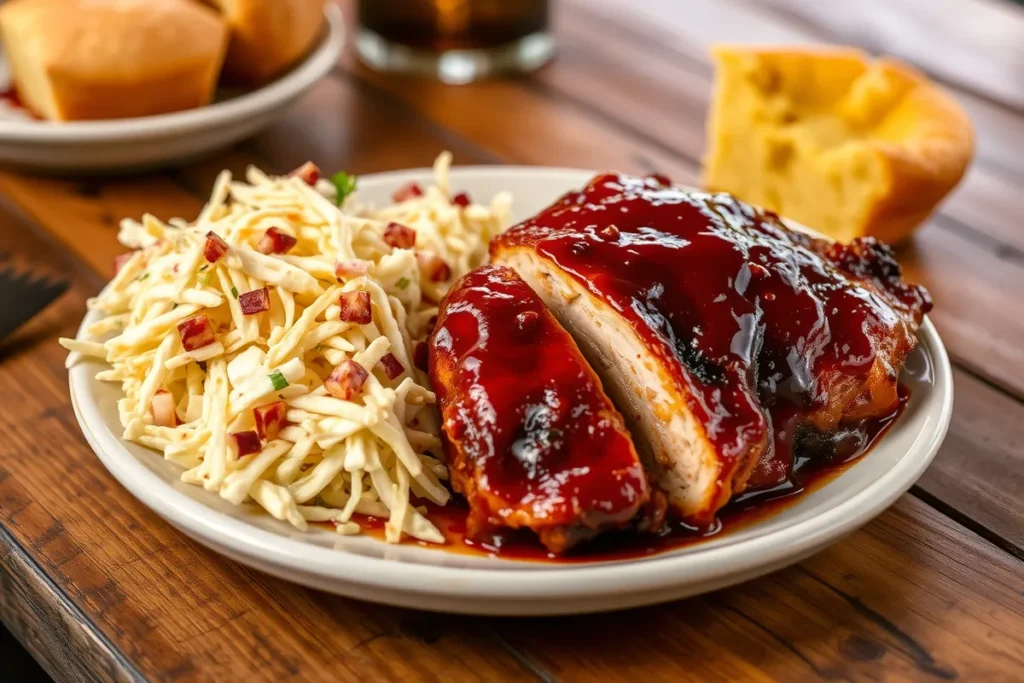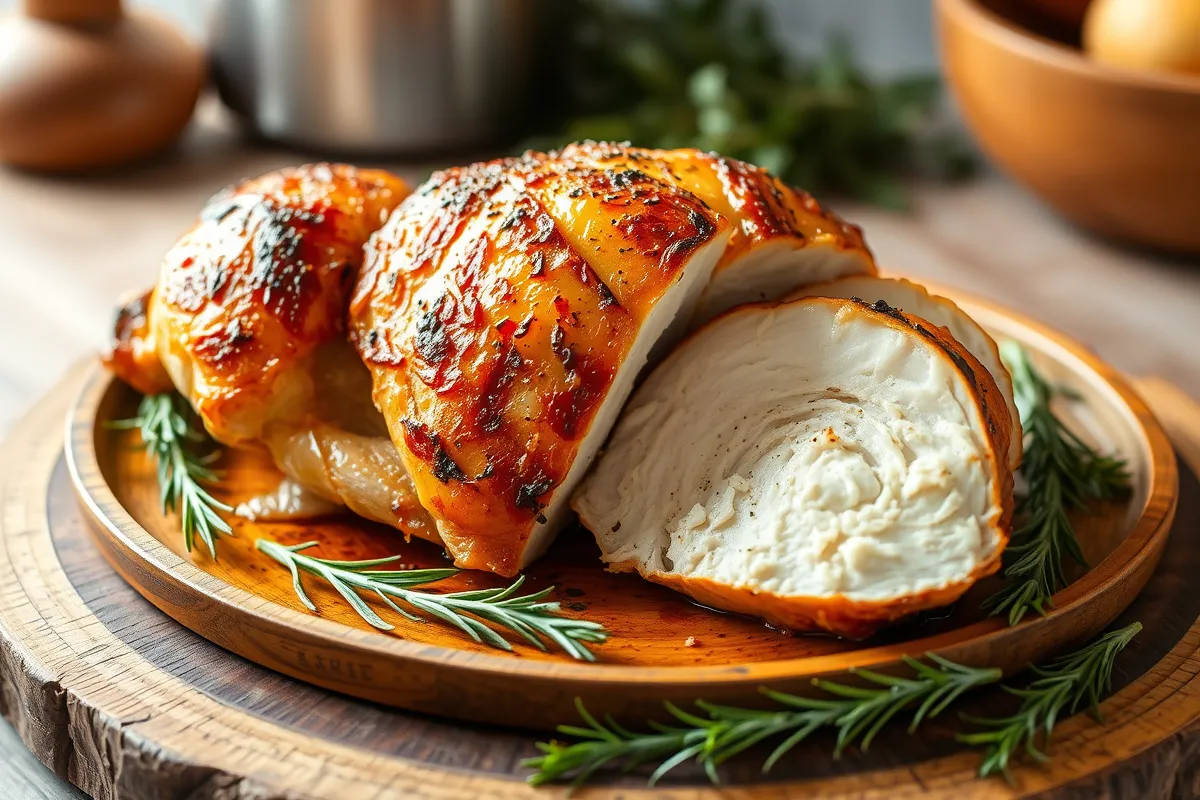Introduction
Split chicken breast recipe is a flavorful and versatile cut that has earned its place in many kitchens. Known for its rich taste and moist texture, it’s a favorite among both home cooks and professional chefs. This bone-in, skin-on chicken breast option is not only budget-friendly but also easy to prepare in various ways.
Whether you are baking, grilling, or slow-cooking, split chicken breast provides a delicious base for countless recipes. Its bone and skin add depth to the flavor, making it ideal for hearty meals. Additionally, this cut is packed with essential nutrients like protein and vitamins, contributing to a balanced diet.
This article will explore everything you need to know about cooking split chicken breasts. From selecting the best pieces to mastering cooking techniques, you’ll have all the tips to achieve perfectly tender and juicy results every time.
What is a Split Chicken Breast
Split chicken breast refers to a bone-in, skin-on chicken breast that has been “split” down the center. This creates two halves, each with its unique flavor and texture, thanks to the bone and skin. Unlike boneless chicken breasts, split chicken breasts retain more natural juices during cooking, making them an excellent choice for recipes requiring deep flavor.
The bone in a split chicken breast acts as a conductor of heat, ensuring even cooking and enhancing the meat’s tenderness. Meanwhile, the skin locks in moisture and adds a delightful crispiness when roasted or grilled. Compared to their boneless counterparts, these cuts are often more affordable, making them a cost-effective option for families.
Many recipes highlight the advantages of cooking split chicken breasts. Their structure holds up well to various cooking methods, whether you’re baking them with herbs, grilling with spices, or slow-cooking them with sauces. This cut is ideal for those who want maximum flavor with minimal effort.
Nutritional Benefits of Split Chicken Breast
Split chicken breasts are not only delicious but also highly nutritious, making them an excellent choice for health-conscious individuals. Packed with lean protein, this cut is ideal for supporting muscle growth, repairing tissues, and keeping you full for longer. A single serving of split chicken breast can provide over 25 grams of protein, making it a powerhouse ingredient for your meals.
In addition to protein, split chicken breasts are rich in essential vitamins and minerals. They contain significant amounts of B vitamins, particularly niacin and B6, which are crucial for energy production and brain health. Furthermore, they provide important minerals like phosphorus and selenium, which support bone health and boost the immune system.
What sets split chicken breasts apart nutritionally is their natural fat content. The skin adds a small amount of healthy fat, which not only enhances the flavor but also contributes to satiety. Removing the skin, however, reduces the fat content, making it a versatile choice for those following specific dietary preferences.
Whether you’re looking to build a balanced diet or fuel an active lifestyle, split chicken breasts offer the perfect combination of flavor and health benefits.
Selecting Quality Split Chicken Breasts
Choosing the right split chicken breast is the first step toward preparing a flavorful and satisfying dish. Ensuring that you start with fresh, high-quality chicken makes a noticeable difference in the taste and texture of your meal.
When shopping for split chicken breasts, look for cuts with skin that appears smooth and free of blemishes. The skin should have a natural, pale color without any discoloration or dryness. The flesh beneath should feel firm to the touch, indicating freshness. Avoid chicken that has a strong or unpleasant odor, as this can be a sign of spoilage.
Consider whether you want organic or conventional chicken. Organic chicken is often raised without antibiotics or added hormones, making it a cleaner option. While it may cost slightly more, many people find the improved taste and ethical considerations worth the investment.
Another important factor to keep in mind is the size of the split chicken breasts. Larger pieces may take longer to cook but often provide juicier results, while smaller cuts can be more convenient for quicker recipes.
By selecting high-quality split chicken breasts, you set the foundation for a dish that is both delicious and wholesome.
Preparing Split Chicken Breasts for Cooking
Proper preparation is key to unlocking the full potential of split chicken breasts. Taking a few extra steps before cooking ensures that the meat stays tender, juicy, and flavorful.
Cleaning and Trimming
Start by rinsing the split chicken breasts under cold water to remove any residue or debris. Pat them dry with paper towels to ensure a good sear if you’re grilling or pan-frying. If desired, trim away excess fat or loose skin using a sharp knife, but keep the majority of the skin intact for enhanced flavor and moisture retention.
Brining for Moisture
One of the best ways to achieve juicy chicken is by brining. A simple saltwater solution—made with water, salt, and optional seasonings like garlic or herbs—helps the chicken retain moisture during cooking. Submerge the chicken in the brine for at least one hour, or up to overnight, for optimal results.
Marinating for Flavor
If you prefer bold flavors, marinating is an excellent option. Create a marinade with ingredients like olive oil, lemon juice, garlic, and spices. Let the chicken rest in the marinade for at least 30 minutes or up to 12 hours in the refrigerator. This not only enhances taste but also tenderizes the meat.
Resting Before Cooking
Before cooking, allow the chicken to sit at room temperature for 15 to 20 minutes. This helps the meat cook evenly, reducing the chances of dry or undercooked sections.
With these preparation techniques, you’ll be ready to cook split chicken breasts that are full of flavor and perfectly tender.
Cooking Methods for Split Chicken Breasts
Split chicken breasts are incredibly versatile and can be cooked using a variety of methods. Each technique brings out unique flavors and textures, making this cut suitable for countless recipes. Below are the most popular ways to cook split chicken breasts, along with tips to achieve perfect results.
Baking
Baking is one of the simplest and most reliable methods for cooking split chicken breasts. The oven’s even heat ensures that the meat is tender and juicy while the skin becomes delightfully crisp.
- Preparation: Preheat your oven to 375°F (190°C). Season the chicken generously with salt, pepper, and your favorite herbs or spices.
- Cooking: Place the chicken on a baking sheet lined with parchment paper or in a greased baking dish. Bake for 35-40 minutes, or until the internal temperature reaches 165°F (74°C).
- Tips: For extra moisture, brush the chicken with melted butter or olive oil before baking.
Grilling
Grilling split chicken breasts infuses them with smoky flavor and creates a beautifully charred exterior.
- Preparation: Preheat your grill to medium-high heat. Season the chicken and lightly coat it with oil to prevent sticking.
- Cooking: Place the chicken skin-side down on the grill. Cook for 6-8 minutes per side, flipping occasionally. Use a meat thermometer to check for doneness.
- Tips: For even cooking, use indirect heat by moving the chicken to a cooler part of the grill after searing.
Slow Cooking
Slow cooking is ideal for achieving tender, fall-off-the-bone split chicken breasts with minimal effort.
- Preparation: Season the chicken and layer it in a slow cooker with vegetables or sauces like barbecue or tomato-based marinades.
- Cooking: Cook on low for 6-8 hours or on high for 3-4 hours.
- Tips: To prevent the chicken from drying out, ensure there is enough liquid in the cooker.
Pan-Seared and Oven-Finished
For a mix of crispy skin and tender meat, try searing split chicken breasts in a skillet before finishing them in the oven.
- Preparation: Heat a cast-iron skillet over medium-high heat with a tablespoon of oil. Season the chicken.
- Cooking: Sear the chicken skin-side down for 3-4 minutes until golden brown. Transfer the skillet to a preheated 375°F (190°C) oven and cook for an additional 25-30 minutes.
- Tips: Baste the chicken with pan juices halfway through for extra flavor.
Each cooking method highlights the natural qualities of split chicken breasts, allowing you to choose the perfect technique for your meal.
Popular Split Chicken Breast Recipes
The ordinary split chicken breast recipe can be transformed into a variety of delicious dishes that suit different occasions and tastes. Here are some standout recipes that showcase the versatility of this flavorful cut.
Baked Split Chicken Breast with Herbs
This classic recipe highlights the natural flavors of the chicken with a blend of fresh herbs and a crisp, golden skin.
- Ingredients:
- 2 split chicken breasts
- 2 tablespoons olive oil
- 1 teaspoon salt
- 1 teaspoon black pepper
- 1 teaspoon garlic powder
- 1 tablespoon fresh rosemary, chopped
- 1 tablespoon fresh thyme, chopped
- Instructions:
- Preheat the oven to 375°F (190°C).
- Rub the chicken breasts with olive oil and season with salt, pepper, garlic powder, rosemary, and thyme.
- Place the chicken on a baking tray lined with parchment paper.
- Bake for 35-40 minutes, or until the internal temperature reaches 165°F (74°C).
- Let the chicken rest for 5 minutes before serving.
Grilled Lemon Garlic Split Chicken Breast
This recipe brings a bright and zesty twist to grilled chicken, making it perfect for summer meals.
- Ingredients:
- 2 split chicken breasts
- Juice of 1 lemon
- 3 cloves garlic, minced
- 2 tablespoons olive oil
- 1 teaspoon paprika
- 1 teaspoon salt
- 1/2 teaspoon black pepper
- Instructions:
- In a small bowl, whisk together lemon juice, garlic, olive oil, paprika, salt, and pepper.
- Marinate the chicken in the mixture for at least 30 minutes or up to 12 hours.
- Preheat the grill to medium-high heat.
- Grill the chicken for 6-8 minutes per side, or until the internal temperature reaches 165°F (74°C).
- Serve with a garnish of fresh parsley or lemon wedges.
Slow Cooker BBQ Split Chicken Breast
For an easy and comforting dish, this recipe pairs tender chicken with a tangy barbecue sauce.

- Ingredients:
- 2 split chicken breasts
- 1 cup barbecue sauce
- 1/2 cup chicken broth
- 1 teaspoon smoked paprika
- 1 teaspoon garlic powder
- Instructions:
- Season the chicken with smoked paprika and garlic powder.
- Place the chicken in a slow cooker and pour the barbecue sauce and chicken broth over it.
- Cook on low for 6-8 hours or on high for 3-4 hours.
- Serve with rice, mashed potatoes, or coleslaw.
These recipes demonstrate how simple ingredients and techniques can create flavorful and satisfying meals.
Tips for Juicy and Flavorful Split Chicken Breast Recipe
Cooking split chicken breasts to perfection involves more than just following a recipe. With these practical tips, you can elevate your dishes and ensure juicy, flavorful results every time.
Rest the Chicken After Cooking
Allowing the chicken to rest after cooking is a critical step that often gets overlooked. Resting the meat for 5 to 10 minutes lets the juices redistribute, ensuring a moist and tender texture when sliced. Cover the chicken loosely with foil during this time to retain warmth.
Use a Meat Thermometer
One of the most effective ways to prevent overcooking is by using a meat thermometer. Insert the thermometer into the thickest part of the breast, avoiding the bone. Once the internal temperature reaches 165°F (74°C), your chicken is perfectly cooked and safe to eat.
Brining for Extra Moisture
Brining is a game-changer for split chicken breasts. The saltwater solution not only enhances flavor but also helps the meat retain moisture during cooking. Add herbs, garlic, or citrus slices to the brine for an extra layer of flavor.
Basting for Added Flavor
While baking or grilling, basting the chicken with its juices or a flavorful marinade can prevent dryness. Brush the chicken with melted butter, olive oil, or your chosen marinade every 10 minutes to keep the surface moist and flavorful.
Avoid Overcooking
Overcooked chicken can become tough and dry, so it’s essential to monitor cooking time closely. If using an oven, check the chicken 5 minutes before the recommended cooking time ends. For grilling, move the chicken to indirect heat if it’s cooking too quickly.
Season Generously
Don’t be afraid to season split chicken breasts liberally. The skin and bone can absorb bold flavors, so use a mix of spices, herbs, and even citrus zest to enhance the dish.
With these tips in mind, you can achieve restaurant-quality results with split chicken breasts, no matter the cooking method.
Common Mistakes to Avoid When Making Split Chicken Breast Recipe
Even with the best intentions, a few common mistakes can lead to less-than-perfect split chicken breasts. Avoid these pitfalls to ensure your dish turns out flavorful, tender, and juicy every time.
Overcooking the Chicken
One of the most frequent mistakes is overcooking, which results in dry and tough chicken. Always use a meat thermometer to check for doneness. Remember, the internal temperature should reach 165°F (74°C). Removing the chicken from heat slightly earlier and allowing it to rest can also prevent overcooking.
Skipping the Seasoning
Seasoning split chicken breasts adequately is crucial for bringing out their flavor. A lack of seasoning can make even the best-cooked chicken taste bland. Use a combination of salt, pepper, and your favorite spices or marinades to create depth in flavor.
Cooking at Incorrect Temperatures
Cooking split chicken breasts at temperatures that are too high or too low can lead to uneven results. High heat can burn the outside while leaving the inside undercooked, while low heat might dry out the meat. Stick to recommended temperatures for your chosen cooking method, such as 375°F (190°C) for baking.
Forgetting to Rest the Chicken
Cutting into the chicken immediately after cooking can cause the juices to escape, leading to dry meat. Always let the chicken rest for 5 to 10 minutes before slicing. This small step makes a significant difference in moisture retention.
Neglecting Proper Preparation
Failing to prepare the chicken properly—such as skipping brining, marinating, or trimming excess fat—can affect the overall quality of the dish. Taking a few extra minutes to prepare the chicken correctly ensures better flavor and texture.
Not Using the Right Tools
Using dull knives or skipping tools like a meat thermometer can lead to unnecessary frustration and subpar results. Invest in quality tools to make the cooking process smoother and more precise.
By avoiding these common mistakes, you’ll consistently create split chicken breasts that are juicy, flavorful, and perfectly cooked.
Frequently Asked Questions about Split Chicken Breast Recipe
What’s the difference between split chicken breast and chicken breast?
The primary difference lies in the preparation and presentation. A split chicken breast refers to a bone-in, skin-on chicken breast that is divided into two halves. In contrast, chicken breast usually refers to the boneless, skinless variety. The bone and skin in split chicken breasts add extra flavor and moisture during cooking, while boneless breasts are leaner and cook faster.
How do you tenderize split chicken breast?
Tenderizing split chicken breasts can be done using several techniques. One effective method is brining, which involves soaking the chicken in a saltwater solution to enhance moisture and tenderness. Marinating with acidic ingredients like lemon juice, yogurt, or vinegar also helps break down muscle fibers, making the meat more tender. Additionally, cooking at the right temperature and avoiding overcooking are crucial for achieving tender results.
What is the best way to cook chicken breast without drying it out?
To prevent chicken breast from drying out, use cooking methods that retain moisture, such as baking, grilling, or slow cooking with sufficient liquid or fat. Brining the chicken before cooking adds moisture, while basting during cooking keeps the surface hydrated. Using a meat thermometer to ensure precise cooking and allowing the chicken to rest before slicing are also key steps to maintaining juiciness.
These FAQs address common concerns and provide helpful tips for getting the most out of split chicken breasts.
We also covered previously Quick and Flavorful Diced Chicken Recipes. Make sure to take a look at it.
Conclusion
Split chicken breasts are a fantastic ingredient for creating flavorful, nutritious, and versatile meals. Their bone-in, skin-on structure not only enhances the taste but also ensures juiciness when cooked properly. Whether you prefer baking, grilling, or slow cooking, this cut adapts beautifully to a wide range of recipes and cooking styles.
By selecting high-quality chicken, preparing it with care, and following proven techniques, you can consistently achieve tender and delicious results and succeed in your split chicken breast recipe. Avoiding common mistakes like overcooking or under-seasoning will further elevate your dishes. Plus, incorporating helpful practices like brining and using a meat thermometer guarantees success every time.
From classic baked split chicken breasts with herbs to bold flavors like grilled lemon garlic or slow-cooked barbecue, the possibilities are endless. Split chicken breast recipe allows you to explore various flavors while enjoying the nutritional benefits of this lean and protein-packed ingredient.
Whether you’re cooking for a weeknight dinner or a special occasion, split chicken breasts are a reliable choice that never disappoints. Try out the tips and recipes shared in this guide, and elevate your cooking to the next level.

